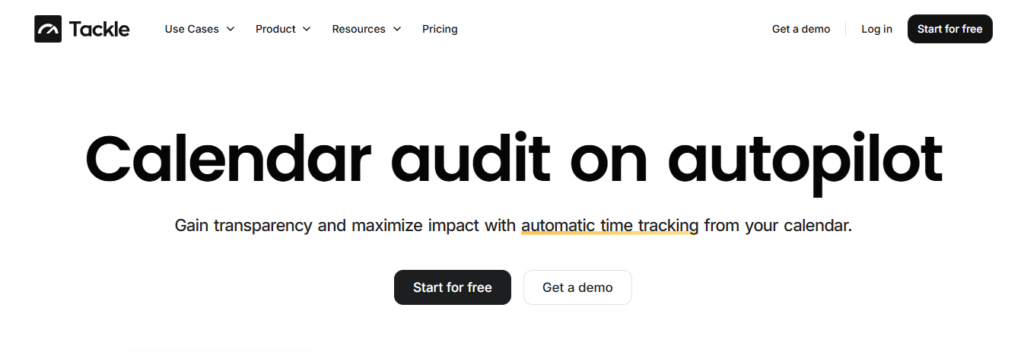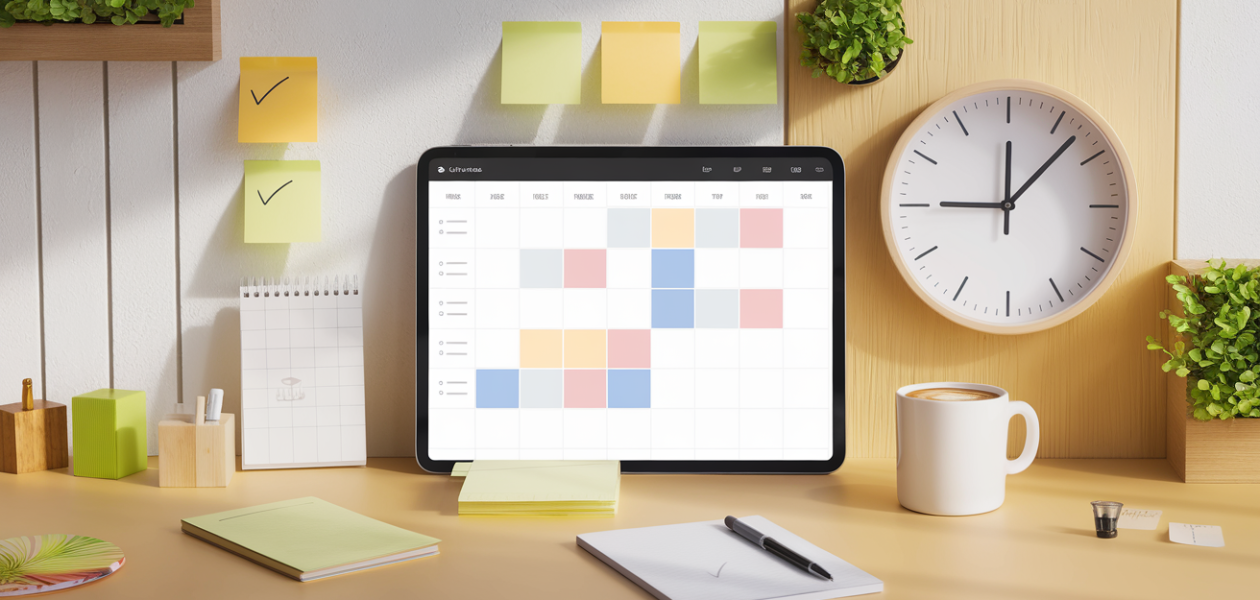Knowing how many weekend days you get each year matters more than you think, especially when you use the best free habit tracker app to build routines and protect downtime. Most years give 104 weekend days, but calendar shifts and leap years can raise that to 105 or even 106, which changes how you schedule rest, hobbies, and habit streaks. This article breaks down the calendar math and offers practical tips for how to make the most of it.
To help with that, Tackle’s automatic time tracking software shows where your time goes, highlights free days, and makes it easier to plan weekends that support your goals.
Standard Weekend Day Count

Most calendars use 52 full weeks per year, which gives you 52 Saturdays and 52 Sundays. Multiplying 52 by two yields 104 weekend days, which serves as the baseline for many people’s yearly planning, time off, and event scheduling.
Weekend Days in 2025: A Clear Example You Can Use
The year 2025 has 365 days and begins on a Wednesday, so it follows the standard pattern: 52 Saturdays and 52 Sundays, for a total of 104 weekend days. Some months in 2025 contain five full weekends, meaning five Saturdays and five Sundays in the same month; those months are March, May, August, November, and December.
How Weekend Counts Can Rise to 105 or 106 Days
A regular year has 365 days, which equals 52 weeks plus one extra day. If that extra day falls on a Saturday or Sunday, you wind up with 105 weekend days. Leap years add one more day, giving 52 weeks plus two additional days.
If both of those extras land on weekend days, the year can reach 106 weekend days. Calendar alignment also matters: when January 1 or December 31 falls on a weekend, you can pick up an extra Saturday or Sunday. To quickly check any year, find the day of the week for January 1, add one additional day for normal years or two for leap years, and see whether those extra days are Saturday or Sunday.
Related Reading
- Happy Friday Meme
- How Many Work Weeks in a Year
- Friday Memes for Work
- Leadership Interview Questions
- How Many Working Hours in a Month
Importance of Understanding Weekend Counts

A standard year has 365 days. That breaks into 52 full weeks, which gives 104 weekend days (52 Saturdays and 52 Sundays). One extra day in a common year means one weekday appears 53 times, so weekend days can total 104 or 105, depending on which day that extra day is.
In a leap year, there are 366 days, so two weekdays occur 53 times, and the total weekend days can be 104, 105, or 106. Check the calendar for the weekday of January 1 and whether the year is a leap year to get a precise weekend count.
Maximize Family Time: Use Weekend Counts to Plan Better
Knowing how many weekends and which months have five weekends helps you schedule family events, short trips, and personal projects with less friction. Five-weekend months create extra free blocks for day trips, workshops, or visiting relatives without burning vacation days. Mark those on a shared calendar and slot recurring family priorities into them.
Staffing and Pay: Why Weekend Counts Matter for Business
Businesses that run on weekends need accurate weekend counts to forecast labour, assign shifts, and calculate payroll correctly. Weekend frequency affects overtime projections, weekend premium pay, and headcount planning across retail, hospitality, and healthcare. Use the yearly weekend distribution to smooth staffing, prevent overwork during busy months, and budget for expected weekend labor costs more reliably.
Stretch Your Time Off: Optimise Vacations and Project Timelines Around Weekends
Thoughtful leave planning stretches your paid days off. Align vacation start and end dates with weekends to create longer breaks while spending fewer leave days. Project managers can schedule milestones and sprints to avoid critical deliverables landing on high-risk weekends, and set buffer days around months with many weekends to reduce rushes. Check which public holidays fall adjacent to weekends in your calendar.
Practical Tips and Tools for Weekend Planning
Count weekends with a simple calendar scan or use a weekend calculator to map blocks of two consecutive days off across the year. Track five-weekend months and note where your team has recurring weekend shifts. Use those insights to set deadlines, plan family time, and forecast payroll more accurately.
Tackle revolutionizes time tracking through seamless calendar integration and automatic capture of work time. Start using our automatic time tracking software for free with one click today.
Related Reading
- How Many Saturdays Are in a Year
- Funny Timesheet Reminder Meme
- How to Make Time Go Faster at Work
- Team Lead Interview Questions
- Submit Your Timesheet Meme
- Cute Friday Memes
- Recruitment Campaign
Maximising Your 104 Weekends

There are 52 weeks in a common year, which gives you 52 weekends or 104 weekend days a year. If you count Saturdays and Sundays as weekend days, a non-leap year has 52 Saturdays and 52 Sundays. Calendar quirks can add extra weekend days.
A year with one additional day gives 105 weekend days when that extra day falls on Saturday or Sunday. A leap year can push the total to 105 or even 106 weekend days, depending on how the year starts.
Must Dos and Want Tos: Choose What Anchors Your Weekend
Must-dos are commitments you cannot move, such as appointments and chores you schedule around other things. Want tos are enjoyable but optional activities you pick when time allows. List everything you want to do for one weekend, then label each item.
Ask yourself which two items you will protect first this weekend. Once you have those anchors, the rest of the weekend can be organized around them.
Time Block Your Weekend Schedule Freedom into the Calendar
Assign specific blocks of time to your anchors and to open windows. Time blocking helps prevent your weekend from becoming a series of reactive choices. Reserve slots for must-dos first, then assign blocks for want tos and flexible free time. Use Google Calendar, Apple Calendar, or Microsoft Calendar and color-code categories so you can see at a glance how your Saturdays and Sundays are divided.
Build Breaks and Downtime Protect Recovery as Part of the Plan
Schedule breaks as real appointments. Give yourself an extra morning to sit with coffee, take a walk after lunch, or read for 30 minutes before dinner. Treat downtime like a requirement, not a gap you fill at the last minute.
Plan Meals, Free Up Thinking Time
Decide early whether you will cook, meal prep, or eat out, and block time for meal tasks. Batch cook or prep components on Friday night or Saturday morning so you trim decision fatigue and reclaim minutes that add up across 104 weekend days. Maintain a simple weekend meal rotation and a concise grocery list to prevent last-minute takeout due to forgotten dinner planning.
Shared Calendar for Family Sync Household Rhythm
Put family activities on a shared calendar and set reminders for games, pickups, and movie nights. A shared calendar reduces conflicts and frees time for intentional family moments. Apps enable each person to add events and view who is on duty for what, allowing family time to be protected rather than improvised.
Limit Screen Time, Reclaim Minutes, and Presence
Set concrete limits for streaming and social media on weekend days. Try one movie per evening or cap social apps at 30 minutes per day on Saturdays and Sundays. Small habits can fragment your weekend more than you expect; for instance, 65 percent of people take their phones to the restroom, which can steal attention and minutes across a weekend. Use focus modes, scheduled Do Not Disturb, or even a physical box where phones go during family time.
Reflect and Adjust: Tune Your Weekend System
Spend 10 to 15 minutes Sunday evening asking what worked, what felt rushed, and what restored you. Use that feedback to adjust your time blocks, reclassify items between must-dos and want-to-dos, or move meal planning earlier.
Work-Life Balance and the Bigger Picture

Weekends often feel shorter because we pack them with too many competing demands. You plan errands, visits with family and friends, home projects, exercise, learning, and sleep. That creates time pressure and makes leisure feel rushed. Research shows that prioritizing a few hours of actual downtime improves mood and focus during the workweek.
Set boundaries that keep work from infecting your whole weekend. Block time for one social activity, one household task, and one quiet period for nothing useful. Use calendars and alarms to protect those hours. Ask yourself which chores can wait until weekday evenings and which activities recharge you the most.
Make small, measurable habits part of your weekend routine. Track one recovery habit, such as a 90-minute hobby session or a no-screens afternoon. Habit tracking helps you notice patterns and maintain momentum, even on longer projects.
How Many Weekend Days are There in a Year, and How Does That Affect Planning
Most people count 52 weekends, which equals 104 weekend days in a typical year. That is the baseline many use when planning vacations, family time, and projects.
Calendar Math Matters
A common year has 365 days, which equals 52 full weeks plus one extra day. That extra day can fall on any weekday. If it falls on Saturday or Sunday, you get 105 weekend days that year. A leap year has 366 days, two extra days, so weekend days can range from 104 to 106, depending on which weekdays the additional days are.
Want a Quick Check for a Specific Year?
Find the weekday of January 1 and count whether the extra day or days include Saturday or Sunday. If one extra day lands on a weekend, you gain one extra weekend day. If both extras land on weekend days, you gain two extra weekend days.
Apply weekend counts to real planning. Use the expected number of weekend days to set realistic monthly goals and to space chores so weekends do not become catch-up zones. Habit trackers can help you allocate weekend time deliberately and keep rest visible on your calendar.
Practical Habits to Protect Weekends Using Free Trackers
Choose a simple free habit tracker that records streaks and weekly targets. Set 3 weekend habits only:
- One social
- One chores
- One rest
Mark them on Friday evening so the weekend starts with a clear plan.
Use The Tracker to Spot Overload.
If you consistently mark chores as completed but miss the rest of the habit, consider shifting chores to weekday evenings or dividing them into 30-minute sessions. Habit data allows you to say no to another event without guilt.
Make rest measurable without making it rigid. Log minutes of low effort activity such as reading, walking, or sitting outside. The tracker turns vague intentions into concrete feedback you can adjust week to week.
Related Reading
- Unique Questions to Ask Leaders
- How Many Hours Do People Work in a Year
- How Many Days in the Year Without Weekends
- Benjamin Franklin Schedule
- Recruitment Campaign
- Payroll Reminder Meme
- Standard Work Hours in a Year
Start Using Our Automatic Time Tracking Software for Free with One Click Today

Connect Google or Outlook, and Tackle pulls your calendar events into time entries without manual logging. The system captures meetings, focus blocks, and customer calls and timestamps them so you can see actual weekday and weekend use. Tackle highlights Saturdays and Sundays separately so that you can count weekend days per year against total work hours.
Smart Tagging and AI That Understands Your Work and Weekends
Set custom tags so Tackle groups calendar events the way your team thinks: client time, strategy, recruiting, internal meetings. The AI suggests automating the tagging of recurring meetings and automatically catching weekend meetings.
Ask yourself how many Saturdays you or your team worked this year and get an instant report. Automation reduces manual cleanup and surfaces patterns like weekend work spikes or recurring off-hour customer calls.
Flexible Reporting to Track Weekend Patterns and Team Efficiency
Use dashboards and flexible reports to compare weekend versus weekday allocation by person, team, or project. Filter by month to view weekend days per month, then roll up to see weekend days per year.
Export data to track overtime, identify which accounts create weekend work, and measure how many weekends in a year are consumed by meetings rather than deep work. The reporting tools enable quick pivoting, allowing you to answer resource allocation questions without building spreadsheets.
How Leadership and Customer-Facing Teams Use These Insights
Executives and team leads use Tackle to protect strategic time and reduce unnecessary weekend hours. Customer-facing professionals get visibility into after-hours workload so you can staff appropriately. Teams at Roblox, Deel, and Lightspeed Ventures use the platform to track strategic initiatives, measure team efficiency, and ensure resource optimization without forcing timesheets on people.
Get Started Quickly with One Click
Connect your calendar, create a few tags, enable suggested automations, and watch intelligent time capture populate your dashboard. The free plan lets you see the first trends in weekend counts and total time allocation right away, so you can answer practical questions about how many weekend days in a year your team spends working and where to act.
